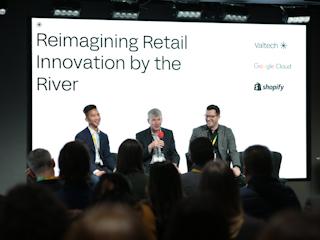2023-11-16
Have you ever tried to buy something after seeing an eye-catching ad on Instagram or Facebook, only to face a clunky payment process? For millions of people, what should be an easy purchase turns into frustration — and a lost sale.
Seven out of 10 online shopping carts are abandoned, according to Baymard Institute research.
Kami Kris, Managing Director of Commerce, says that nearly all consumers shop online, whether for personal items or as part of a business engaging with a complex B2B ordering process. One note rings true for all shoppers — they expect more. “Having a straightforward buying experience isn’t setting the bar very high anymore,” Kris explains.
Delivering harmonious experiences today requires considering the customer’s perspective at every moment across every channel. The goal is to orchestrate a symphony of touchpoints, each note creating a compelling and cohesive customer experience.
Expanding the range of ‘customer experience’
Commerce is in flux.
Instead of multichannel, we talk about omnichannel or unified channel. Instead of buying on desktop, we’re mobile-first. Even the term “eCommerce” has less meaning today, as brand affinity spans channels (think buy online, pick up in-store).
Commerce is a broad category, so defining and designing the ideal customer experience will be different for a traditional retail brand compared to a direct-to-consumer (D2C) or business-to-business (B2B) company.
Traditionally, many consumer brands have relied on retailers to distribute merchandise. “That’s changing, with many brands increasingly choosing to have a direct relationship with their customer in order to better harvest and collect customer insights and data,” says Joe Woods, Managing Director, Growth at Valtech. “They can then feed that back into product line improvement or customer-targeted messaging.”
B2B commerce has also become more digitized and less dependent on field sales and high-touch sales cycles. Portal sites and product data systems help firms streamline product discovery by end users, internal customers and third-party partners.
For electrical industry solutions provider Southwire, that meant revisiting the entire purchasing process from the customer’s perspective. “We had interviews. We polled them,” explains Dustin Davis, Director, Inside Sales, Wire and Cable Support, Southwire. “We wanted to understand what they need, what they want, what they see.”
Southwire then made strategic investments to implement what they learned from those customer insights, while acknowledging that this type of evolution doesn’t happen overnight. Changes have included modernizing equipment to create a connected factory that enables data-driven demand planning and product availability. “In our core wire and cable market, we seek to lead the pack in terms of putting this digital capability in front of our customers,” Davis notes.
And he's quick to point out how collaborative this work has been. A business transformation team helps facilitate the effort, but every function within the business contributes in some way: “From IT. From operations. From product management. From sales. It's a very, very collective goal that we're marching towards.”
“In our core wire and cable market, we seek to lead the pack in terms of putting this digital capability in front of our customers.”
– Dustin Davis, Director, Inside Sales, Wire and Cable Support at Southwire
Composing melodies for an audience of one
In exchange for sharing insights, consumers have come to expect highly tailored experiences that cater to their preferences and needs.
Personalization today is so much more than “Dear [First Name]” emails. It’s about using advanced analytics and AI to understand customer preferences and shopping behaviors so you can deliver relevant and timely experiences while handling personal data responsibly.
That tradeoff is top of mind for many, according to research by CommerceNext and CommX. The survey found that 66% of consumers prefer to buy from stores that know their preferences, and 60% find value in relevant product recommendations. However, 87% also reported being very concerned about how retailers are using their personal information and data, with 67% saying they will only share data if they know it is being safely stored.
Progressive personalization is one way to close that gap, notes Matthew Hildon, Retail & Travel Portfolio Director. Instead of asking for pages of information upfront for someone to join a loyalty program, start with the basics: a username. Every additional request for data should be accompanied by an explanation of how that data would be used to benefit the consumer. “It’s all about transparency and trust,” Hildon says.
Successful brands also know they can’t be everything to everyone. Instead, they focus on maximizing the value of every interaction for each individual based on their priorities and preferences. “Businesses need to be really intentional about how they are supporting the consumer. Not all consumers, but the consumer that they're targeting at that time. Personalized experiences matter,” Kris says.
In many ways, the increasing sophistication of social selling represents the evolution of the commerce experience. Personalization and accurate targeting can transform mindless scrolling into an engaging shopping experience. This connection is crucial, as winning business on social media requires overcoming customer fears about authenticity, product quality and proper delivery. Even the most trusted social selling platform, Facebook, has only earned the confidence of 45% of buyers.
This is as true for B2B businesses as it is for B2C. Nearly two-thirds of B2B companies are investing in personalization and user experience, according to research from Adobe and Digital Commerce 360. The survey also found B2B companies succeeding with AI-powered search results that are personalized based on the user’s on-site behavior. This personalization extends to product recommendations and customized payment and shipping options — a harmonious ensemble of touch points that creates lasting impact.
“Businesses need to be really intentional about how they are supporting the consumer. Not all consumers, but the consumer that they’re targeting at that time. Personalized experiences matter.”
– Kami Kris, Managing Director of Commerce
Hitting all the right notes together
Today’s brands need to go beyond individual interactions and deliver fully holistic experiences.
Going off-key will be swiftly punished; 86% of shoppers surveyed by Emplifi will leave a trusted brand after only two poor customer experiences. And one in six shoppers won’t give any grace, abandoning purchases after a single bad experience. The same goes for fulfillment. Getting orders right is table stakes. The real challenge is in delivering moments of delight that truly engage customers.
Designing a unified commerce experience requires establishing a strong foundation of data that can be used to drive operational efficiencies, improve targeting and create hyper-personalized shopping experiences. From there, brands can unleash digital capabilities to improve the customer experience — applying machine learning for personalized product recommendations or leveraging AI for automatic price optimization and demand forecasting.
The rise of “composable commerce” is enabling businesses to make this leap faster while controlling costs, says Meghan Stabler, SVP Marketing at BigCommerce. MACH (microservices, API-first, cloud-native and headless) architecture allows you to swap in the components that you need when you need them. “Your ROI is stronger in a composable world than it would be in a monolithic world where you’ve got to replace the entire tech stack.”
A symphony of touchpoints
Delivering a harmonious customer experience has become the key to success for brands across industries. As consumer expectations continue to rise, businesses must go beyond simply providing a straightforward buying experience. They must orchestrate a symphony of touchpoints, seamlessly blending online and offline interactions, and creating personalized, emotional connections with their customers.
By understanding the customer journey and identifying pain points, brands can fine-tune their strategies to meet individual needs. Consistency across channels, both in messaging and visuals, ensures a cohesive brand identity that resonates with customers. Empathy and emotional connection become the driving force behind exceptional customer service, while the integration of offline and online experiences creates immersive moments that leave a lasting impression.










